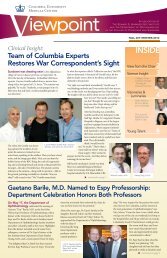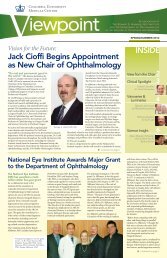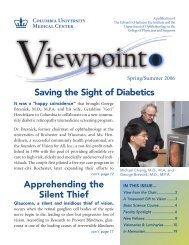Faculty Spotlight - Department of Ophthalmology, Columbia University
Faculty Spotlight - Department of Ophthalmology, Columbia University
Faculty Spotlight - Department of Ophthalmology, Columbia University
Create successful ePaper yourself
Turn your PDF publications into a flip-book with our unique Google optimized e-Paper software.
View<br />
from the Chair<br />
Dear Friends,<br />
The gift <strong>of</strong> vision is precious at any age, but especially so for children.<br />
Prompt and proper ophthalmic treatment in children can make the difference<br />
between a lifetime <strong>of</strong> joyful sight and a debilitating, isolating and<br />
costly disability. At the Edward<br />
Harkness Eye Institute, we recognize<br />
that children are not just<br />
“small adults” – they are growing<br />
and changing human beings<br />
who require specialized and vigilant<br />
care that respects their<br />
unique developmental needs.<br />
In this issue <strong>of</strong> Viewpoint,we<br />
showcase our stellar pediatric<br />
ophthalmology team, led by<br />
John Flynn, M.D. He and his<br />
team, including Michael<br />
Chiang, M.D., Howard Eggers,<br />
M.D., Pamela Gallin, M.D. and<br />
Robert Lopez, M.D., are leading<br />
the way in providing comprehensive, highly individualized and coordinated<br />
care for children and babies with eye and orbital diseases.<br />
We also pr<strong>of</strong>ile Amilia Schrier, M.D., the new A. Gerard DeVoe–B. Dobli<br />
Srinivasan Director <strong>of</strong> Ambulatory Eye Care for the ITT Eye Clinic, and<br />
Ilyas Washington, Ph.D., an organic chemist and the newest member <strong>of</strong><br />
our research staff. Dr. Washington, who recently completed a post-doctoral<br />
fellowship with <strong>Columbia</strong>’s <strong>Department</strong> <strong>of</strong> Chemistry, is combining<br />
Green Energy for the Eye continued from page 1<br />
in vision, a function previously attributed<br />
exclusively to the visual protein rhodopsin.<br />
Chlorophyll derivatives provide something<br />
akin to near infrared vision that may improve<br />
the ability to drive at night and under adverse<br />
conditions such as fog, haze, smoke, rain<br />
or snow.<br />
“Carrots get all the credit,” Dr. Washington<br />
quips. “But the chlorophyll molecules in<br />
green vegetables may actually help improve<br />
long-wavelength vision. The next step is to<br />
investigate how many <strong>of</strong> these chlorophyll<br />
molecules actually get to the eye via the<br />
digestive process."<br />
These promising results also suggest that<br />
chlorophyll derivatives can be used to capture<br />
light and convert it into chemical energy to<br />
power cellular processes <strong>of</strong> the eye. His next<br />
research avenue involves combining chlorophyll<br />
derivatives with nanotechnology to initiate<br />
the transformation <strong>of</strong> sunlight into<br />
energy for the eye. He hypothesizes that special<br />
nano solar cells could be introduced into<br />
the eye via eye drops to provide auxiliary<br />
energy to combat age-related vision loss.<br />
“As people age, there seems to be a drop in<br />
adenosine triphosphate [ATP] synthesis,<br />
Vıewpoınt 2 SPRING/SUMMER 2007<br />
which is the energy currency <strong>of</strong> cells. When<br />
that drops, the cells begin to die. If we can<br />
develop ways to increase ATP synthesis in<br />
the eye, we may be able to impede cellular<br />
death and even help eyes heal more quickly<br />
following injury or surgery,” explains<br />
Dr. Washington.<br />
Charles Manley<br />
“I find the eye fascinating because it is an<br />
area <strong>of</strong> study where many disciplines come<br />
together. I try not to look at science as separate<br />
disciplines. Rather, we need to step back<br />
and let the problem be the catalyst that combines<br />
all these sciences,” Dr. Washington says.<br />
“We are living in a revolutionary time for science.<br />
In the past, lack <strong>of</strong> access to information<br />
was a barrier to collaboration across<br />
fields. Now, with ingenuity and easy access to<br />
information via the Internet, real potential<br />
for new discoveries exists. I am deeply<br />
honored to join the <strong>Department</strong> <strong>of</strong><br />
<strong>Ophthalmology</strong> because it presents<br />
tremendous opportunities to collaborate<br />
with world-class faculty from diverse<br />
scientific backgrounds.”<br />
With a Ph.D. from the <strong>University</strong> <strong>of</strong><br />
California at Los Angeles and a broad background<br />
in computational, physical organic,<br />
photo and bio-organic chemistry, Dr.<br />
the study <strong>of</strong> sunlight, chlorophyll derivatives and nanotechnology in<br />
innovative ways to stem age-related vision loss.<br />
Finally, Mr. and Mrs. Bernard Brown, treasured members <strong>of</strong> our<br />
Advisory Board, have established the Shirlee and Bernard Brown<br />
Pr<strong>of</strong>essorship, an endowed pr<strong>of</strong>essorship in glaucoma, to complement<br />
their already generous support for the Brown Glaucoma Laboratory. We<br />
are tremendously grateful for their leadership role in the Vision for the<br />
Future campaign and their unwavering support for glaucoma research.<br />
Robert L. Burch III, another esteemed Advisory Board member, has<br />
made an equally impressive gift to underwrite laboratory renovations<br />
and research support for Kosta Petrukhin, Ph.D. in his quest for new<br />
treatments for age-related macular degeneration.<br />
With appreciation for the blooms <strong>of</strong> spring and the dedication and commitment<br />
behind our donors’ altruism, I extend renewed thanks to each<br />
<strong>of</strong> you for your continued generosity and support <strong>of</strong> the Harkness Eye<br />
Institute’s clinical and research endeavors. Every gift truly makes a difference<br />
as we work together to treat and conquer diseases <strong>of</strong> the eye. Thank<br />
you again for all that you do.<br />
With best wishes to you and yours,<br />
Stanley Chang, M.D.<br />
K.K. Tse and Ku Teh Ying Pr<strong>of</strong>essor<br />
Edward S. Harkness Pr<strong>of</strong>essor<br />
Chairman, <strong>Department</strong> <strong>of</strong> <strong>Ophthalmology</strong><br />
Nancy Heim<br />
A nano solar cell targets a cellular compartment where it<br />
initiates the transformation <strong>of</strong> light into chemical energy.<br />
Washington is looking forward to continued<br />
collaboration with <strong>Columbia</strong> researchers and<br />
clinicians to translate such novel discoveries<br />
into clinical treatments. He continues, “To<br />
cure these eye diseases, or any disease, it will<br />
take all <strong>of</strong> science, not just one discipline.”





